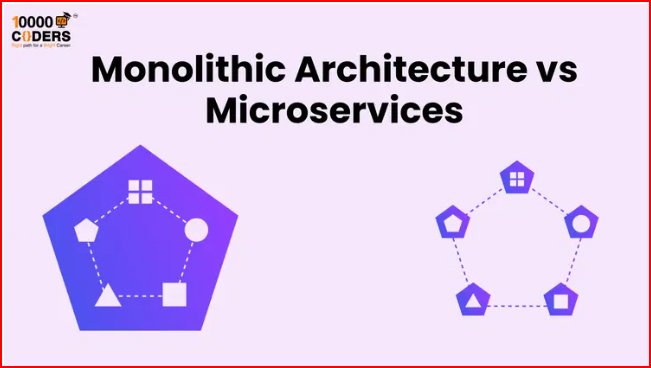Monolithic Architecture vs Microservices: A Comprehensive Comparison
Modern software systems need to be scalable, maintainable, and resilient. Two fundamental approaches to building such systems are Monolithic Architecture and Microservices. This guide explores their concepts, differences, advantages, disadvantages, and how to choose the right one based on your use case.
What is Monolithic Architecture?
Monolithic architecture is a traditional approach where an entire application is built as a single, unified unit. All components like the user interface, business logic, and data access layer are tightly coupled and run within a single codebase and process.
Characteristics
- Single codebase
- Shared memory
- Tight coupling
- Deployed as a single artifact
Example
// Express.js Monolithic example
const express = require('express');
const app = express();
app.get('/user', (req, res) => {
// User controller logic
res.send('User endpoint');
});
app.get('/order', (req, res) => {
// Order controller logic
res.send('Order endpoint');
});
app.listen(3000, () => console.log('Server running on port 3000'));
What is Microservices Architecture?
Microservices architecture breaks down an application into small, independent services. Each service is responsible for a specific functionality and communicates with other services via APIs, often over HTTP or messaging systems.
Characteristics
- Independent services
- Decentralized data management
- Loose coupling
- Polyglot development
Example
# Docker Compose for Microservices
version: '3'
services:
user-service:
build: ./user-service
ports:
- "3001:3000"
order-service:
build: ./order-service
ports:
- "3002:3000"
Each service might be a separate repository, with its own database and deployment pipeline.
Microservice (Node.js user-service)
// user-service/index.js
const express = require('express');
const app = express();
app.get('/user', (req, res) => {
res.json({ name: 'Alice', role: 'Admin' });
});
app.listen(3000, () => console.log('User service running on port 3000'));
Microservice (Node.js order-service)
// order-service/index.js
const express = require('express');
const app = express();
app.get('/order', (req, res) => {
res.json({ orderId: 101, item: 'Book' });
});
app.listen(3000, () => console.log('Order service running on port 3000'));
Comparison
Architecture
FeatureMonolithicMicroservicesStructureSingle unitDistributed independent unitsDeploymentSingle deployable artifactMultiple deployable servicesData storageShared databaseDecentralized databasesDevelopmentSingle tech stackPolyglot, diverse stack
Scalability
- Monolith: Vertical scaling (add more resources to a single machine)
- Microservices: Horizontal scaling (scale each service independently)
Performance
- Monolith: Faster in-process calls but may become a bottleneck at scale
- Microservices: Better for high load via distributed load, but includes network latency
Maintainability
- Monolith: Tight coupling makes it harder to isolate and fix issues
- Microservices: Easier to maintain, smaller codebases per service
Use Case Suitability
When to Choose Monolithic
- Small team and project
- Fast initial development
- Tight budget and deadlines
- Simple deployment environment
When to Choose Microservices
- Large, complex systems
- Independent team ownership
- Need for scalability and resilience
- Frequent feature updates
Challenges
Monolithic
- Hard to scale specific modules
- Longer deployment cycles
- High risk of cascading failure
Microservices
- Operational complexity
- Need for distributed tracing and monitoring
- Managing inter-service communication
Best Practices
For Monolithic Systems
- Modularize code for separation of concerns
- Write unit and integration tests
- Use CI/CD for deployment
- Monitor resource utilization
For Microservices
- Use service discovery and API gateways
- Implement centralized logging and monitoring
- Secure service-to-service communication
- Use message brokers for asynchronous communication
# Example service registration (Eureka/Consul)
service:
name: order-service
address: 192.168.1.10
port: 3000
Real-World Examples
CompanyApproachNotesNetflixMicroservicesScales globally with hundreds of servicesShopifyMonolith to Modular MonolithInitially monolithic, slowly modularizingAmazonMicroservicesHandles millions of requests per dayBasecampMonolithicWorks well for product simplicity
Conclusion
Both Monolithic and Microservices architectures have their place. The choice should depend on the project scale, team size, deployment strategy, and business goals.
Key Takeaways
- Monoliths are simple and fast to develop, but harder to scale and maintain.
- Microservices offer scalability and flexibility but require robust DevOps practices.
- Start with monoliths when uncertain, then evolve into microservices as complexity grows.
- Prioritize domain design, deployment strategy, and team capability when making architectural decisions.
📌 Pro Tip: Use a modular monolith as a stepping stone to microservices — it combines the simplicity of a monolith with the separation of concerns found in microservices.
🚀 Ready to kickstart your tech career?





Comments